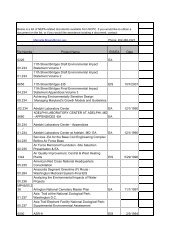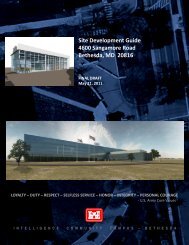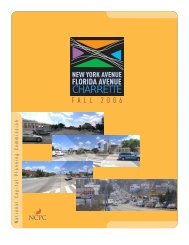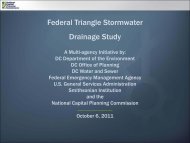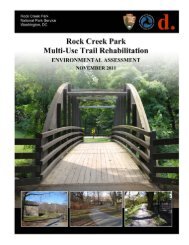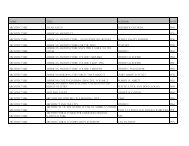Tetratech Interior Drainage Study for Potomac Park - National ...
Tetratech Interior Drainage Study for Potomac Park - National ...
Tetratech Interior Drainage Study for Potomac Park - National ...
You also want an ePaper? Increase the reach of your titles
YUMPU automatically turns print PDFs into web optimized ePapers that Google loves.
MEMORANDUM<strong>Interior</strong> <strong>Drainage</strong> AnalysisAn interior drainage analysis was per<strong>for</strong>med to assess the residual flooding in the area protected by the<strong>Potomac</strong> <strong>Park</strong> Levee system. This analysis looks at both the impacts of rainfall within the District ofColumbia (the interior area) and flood stages on the <strong>Potomac</strong> River and the interaction between theinterior and exterior conditions.The approach <strong>for</strong> the interior drainage analysis relies on an assessment of a range of scenarios to quantifythe anticipated range of flooding associated with the interior ponding area. In several of these scenariosthe impact of the pumping stations were not directly considered. This was deemed necessary because ofthe fact that the system serves an area much larger than the Federal Triangle area. As such, the ability ofthe pumping stations to evacuate floodwaters from the Federal Triangle area depends on the geographicaldistribution of rain and the timing of runoff produced by areas geographically far removed from theFederal Triangle and the pumping stations. There<strong>for</strong>e, the operating procedures <strong>for</strong> the pumping stationsdo not definitively address flooding in the Federal Triangle area in a way that would satisfy the FEMArequirements.Watershed DataTo support the analysis WASA provided a map delineating the Federal Triangle Basin Catchments. Thismap is provided in Appendix A and identifies the individual sewersheds associated with each combinedsewer outflow (CSO). Following the sewershed map is a schematic that shows the layout of the sewersystem in the study area. In conjunction, these two maps with Figure 2 illustrate that the boundary of thewatershed on the ground surface changes once flow is conveyed into the pipe system.Throughout the watershed stormwater is picked up by catch basins distributed throughout the system.WASA provided in<strong>for</strong>mation <strong>for</strong> each sewershed regarding the number of catch basins and the capacity ofthose catch basins to convey flow into the pipe network system.Ponding AreaRunoff that is not conveyed into the pipe system via the catch basins will flow down the streets to the lowpoint of the watershed which is the Federal Triangle area. Once water reaches this area it will collect andpond. Elevation-volume curves were generated using the 2008 LiDAR data that was provided throughthe Office of the Chief Technology Officer (OCTO). Contours and subsequent 3D raster surfaces werecreated from the LiDAR points which were spaced at 100-ft intervals, allowing 2-ft contours to begenerated. Some areas of the topo are distorted due to ‘blurring’ of the data in areas of high nationalsecurity priority such as around the White House, Washington Memorial, and the Capital. The data wasassembled and analyzed in ArcGIS 9.2. The storage-elevation curve is included in Appendix B.<strong>Interior</strong> <strong>Drainage</strong> OutletsThe interior drainage of the Federal Triangle can be drained in two ways: (1) the Constitution Avenuegravity storm drain and (2) the B Street / New Jersey combined sewer system. The Constitution Avenuegravity storm drain ranges in diameter from 57” to 72” pipe and runs <strong>for</strong> approximately one mile alongConstitution Avenue from 6th Street NW to 15th Street NW.The storm drain then turns south, crosses the <strong>National</strong> Mall, and discharges to the <strong>Potomac</strong> River at theTidal Basin. Appendix A includes an analysis of the outlet capacity of this pipe under different tailwaterconditions.The B Street / New Jersey combined sewer flows to the O Street and Main Pumping Stations. Thecombined sewer also contains two gravity overflow points that discharge flows to the Anacostia River.4



